Jewish Children in the Nazi Classroom
Adolf Hitler developed an irrational hatred of Jewish people while living in Vienna before the First World War. In a speech he made in 1923 he asked the question: "Do we wish to restore Germany to freedom and power? If yes, then the first thing to do is to rescue it from the Jew who is ruining our country." (1) Hitler also claimed that the Russian Revolution was the result of a Jewish conspiracy and that they had "established a brutal dictatorship over the Russian people, and now sought to extend it to the rest of Europe and the rest of the world." (2)
In 1926 the Nazi Party formed the Hitler Youth movement. The main objective was to turn the young people of Germany into "good Nazis". (3) This included the development of hostile attitudes towards Jewish children. Hildegard Koch, was a member of the German Girls' League (BDM) and claims that her section leader warned her about the teaching she would receive in the classroom: "The mistresses were mostly pretty old and stuffy. They wanted us to do scripture and, of course, we refused. Our leaders had told us that no one could be forced to listen to a lot of immoral stories about Jews, and so we made a row and behaved so badly during scripture classes that the teacher was glad in the end to let us out." (4)
Nazi Education
Susanne von der Borch was told in the BDM and at school: "We are the master race... The world presented to us was filled only with beautiful people, master race people, full of sport and health. And, well, I was proud about that, and inspired by it. I would call this a grand seduction of youth." (5) Hedwig Ertl claimed that at BDM meetings "we were told all the time that first the Jews were a lower kind of human being, and the Poles are inferior, and anyone who wasn't Nordic was worthless." (6)
Melita Maschmann, another member of the BDM, was told that she must not have Jewish friends. (7) Christa Wolf later commented on the Jewish boy in her class: "He is pale, with a pointed face, dark, wavy hair, and a few pimples... He sits at his desk like a sack of wet flour, and everyone who walks by him... will sock him one." (8)
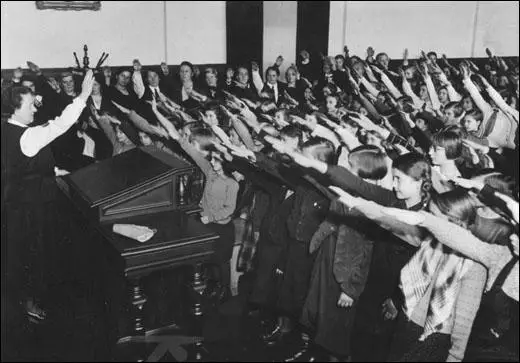
Helga Schmidt became convinced by the anti-semitic propaganda. "There had been a tendency over several years to present the Jews as exploiters. And when that has always been pounded into people's heads, people will also believe it.... Certainly there was something of a negative attitude toward the Jews, but before Hitler it did not exist to the same extent. One tolerated them. One let them live. There was never any particular sympathy for the Jews. But to directly label them as our enemies and exploiters, that came from Hitler... It was well-known that department stores and larger shops in the city center were Jewish. Signs were taped on the windows and doors of the Jewish shops and department stores saying Jew and so on, and we didn't trust ourselves anymore to shop there because it was said that we were being watched. And we believed that." (9)
German children were ordered to write essays with titles such as "The Jews are our misfortune". Rebecca Weisner suffered a great deal in her German school: "When I was six, Hitler came to power. I started school in April 1933, just at the same time... There were some German girls I was friends with - we grew up together - and, all of a sudden, one day I come down and they call me dirty Jew. My friends, the friends I grew up with! I couldn't comprehend it. I would say to my mother, Why do they call me dirty? I am not dirty. And she said, You had better get used to it. You're Jewish, and that is what you have to learn. So just take it. But I didn't want to take it. I fought." (10)
Hedwig Ertl became convinced that the Germans were the master race. The school she attended was an important factor in this: "We had a history teacher who was a very committed National Socialist, and we had four Jewish pupils. And they had to stand up during the class, they weren't allowed to sit down. And one after the other they disappeared, until none were left, but nobody thought much about it. We were told they had moved.... We were told all the time that first the Jews are a lower kind of human being, and then the Poles are inferior, and anyone who wasn't Nordic was worthless." (11)
Armin Hertz remembers the children being allowed to sing Hitler Youth songs in the classroom: "The anti-Semitism was very vivid in school... They were trying to teach us Nazi songs. I vividly remember this song they were marching in the street with. The Hitler Youth, young boys actually of our age, were singing, Das Judenblut vom Messer spitzt, geht's uns nochmal so gut. (The Jews' blood spurting from the knife makes us feel especially good). They were also singing it in the school." (12)
Marianne Gärtner, who went to a private school in Potsdam was also taught that she was a member of the Master Race: "A special period dealt with the role the Jews had played in the German economy, and the threat they represented to the master race. To back up the lecture, a film was shown which portrayed the archetypal Jew as a suave, potbellied and shifty-eyed city type posing beside gargantuan moneybags. Alternatively, he was depicted as a long-bearded, sunken eyed scarecrow of a man who inspired fear and revulsion. The soundtrack spat the film-makers' contempt into the classroom: The Jews are eyesores on the German landscape, boils on the back of the German people, a subhuman species comparable only to rats! A voice seething with chilling hatred: They must be eradicated!" (13)
Some teachers attempted to provide a balanced view but they were often reported by the children to the authorities. In a lesson that was devoted to those who had been killed in the First World War. The teacher said that some Jewish soldiers in the German Army had lost their lives in the conflict. Straight away one of the boys, who was a member of the Hitler Youth, shouted out. "They had died of fright. The Jews don't have a Fatherland." (14)
Hildegard Koch and her BDM friends began a campaign against the Jewish girls in her class. "The two Jewish girls in our form were racially typical. One was saucy and forward and always knew best about everything. She was ambitious and pushing and had a real Jewish cheek. The other was quiet, cowardly and smarmy and dishonest; she was the other type of Jew, the sly sort. We knew we were right to have nothing to do with either of them. In the end we got what we wanted. We began by chalking 'Jews out!' or 'Jews perish, Germany awake!' on the blackboard before class. Later we openly boycotted them. Of course, they blubbered in their cowardly Jewish way and tried to get sympathy for themselves, but we weren't having any. In the end three other girls and I went to the Headmaster and told him that our Leader would report the matter to the Party authorities unless he removed this stain from the school. The next day the two girls stayed away, which made me very proud of what we had done." (15)
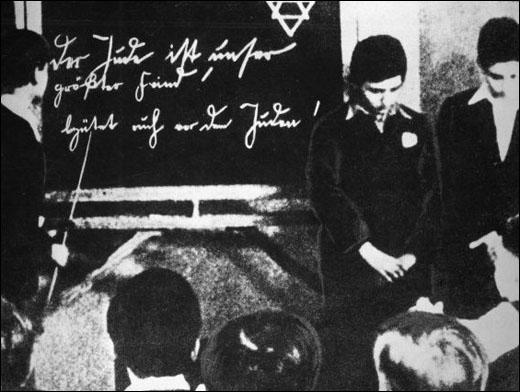
Jewish children in German schools suffered terribly from bullying: "The children called me Judenschwein (Jewish pig)... When I came home I was crying and said, What is a Judenschwein? Who am I? I didn't know who I was. I was only a kid. I didn't know what I was, Jew or not Jew. There were many times when I was beaten up coming from school. I remember one teacher who had something against me because I was a Jew in his class. Every time when I must have been unruly, he used to pull me up front and bend me over and whip me with a bamboo stick." (16)
Inge Fehr was unaware that her parents were Jewish until she was not allowed to take part in collections for winter relief with the Hitler Youth in 1933. When she asked why not she was told it was "because your father is a Jew". Inge, whose family attended the local Lutheran church, was deeply shocked by the news: "It's impossible," I said. I had been taught that a Jew was the lowest form of life, my wonderful father could not be a Jew. Then I found out that my mother was a Jew too so I was classified as a full Jew." (17)
Nazi School Curriculum
After Adolf Hitler gained power in 1933, the school curriculum changed. Cate Haste has argued that education in "racial awareness" began at school and children were constantly reminded of their racial duties to the "national community". Biology, along with political education, became compulsory. Children learnt about "worthy" and "unworthy" races, about breeding and hereditary disease. "They measured their heads with tape measures, checked the colour of their eyes and texture of their hair against charts of Aryan or Nordic types, and constructed their own family trees to establish their biological, not historical, ancestry.... They also expanded on the racial inferiority of the Jews". (18)
As Louis L. Snyder has pointed out: "There were to be two basic educational ideas in his ideal state. First, there must be burnt into the heart and brains of youth the sense of race. Second, German youth must be made ready for war, educated for victory or death. The ultimate purpose of education was to fashion citizens conscious of the glory of country and filled with fanatical devotion to the national cause." (19)
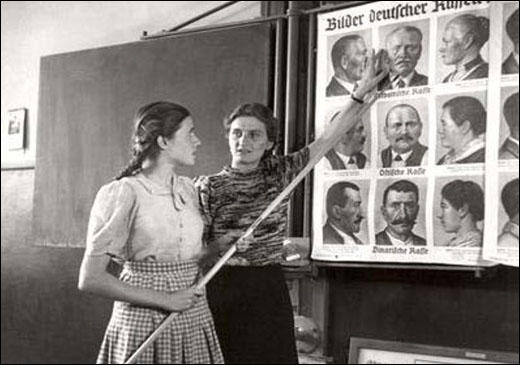
The Minister of the Interior, Wilhelm Frick, claimed that the idea that history teaching should be objective was a fallacy of liberalism. (20) "The purpose of history was to teach people that life was always dominated by struggle, that race and blood were central to everything that happened in the past, present and future, and that leadership determined the fate of peoples. Central themes in the new teaching including courage in battle, sacrifice for a greater cause, boundless admiration for the Leader and hatred of Germany's enemies, the Jews." (21)
In 1933 all Jewish teachers were dismissed from German schools and universities. At this time 12 per cent of all German professors were Jews. During the same year the proportion of Jewish students at universities was reduced to less than 1 per cent, to correspond to the proportion of Jews in Germany. (22)
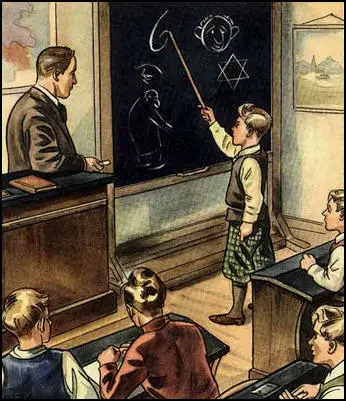
Illustration from a German textbook. The child is saying
“The Jewish nose is bent. It looks like the number six” (1938)
All school textbooks were withdrawn before new ones were published that reflected the Nazi ideology. Additional teaching materials were issued by Nazi teachers' organizations in different parts of the country. A directive issued in January 1934 made it compulsory for schools to educate their pupils "in the spirit of National Socialism". Children were encouraged to go to school wearing their Hitler Youth and German Girls' League uniforms. School noticeboards were covered in Nazi propaganda posters and teachers often read out articles written by anti-semites such as Julius Streicher. (23)
At school Irmgard Paul was brainwashed into accepting Nazi views on the Jewish race. "We used a book with page after page showing the physical differences between Jews and Germans in grotesque drawings of Jewish noses, lips, and eyes. The book encouraged every child to note these differences and to bring anyone who bore Jewish features on the attention of our parents or teachers. I was horrified by the crimes Jewish people were being accused of - killing babies, loan-sharking, basic dishonesty, and conspiring to destroy Germany and rule the world. The description of the Jewish people would convince any child that these were monsters, not people with sorrows and joys like ours." (24)
Life for Jewish children at school became very difficult. Inge Fehr commented: "We were having daily lessons in Race Knowledge, learning about the superiority of the German race. We were told that the... Jews had descended from Negroes.... Miss Dummer, my form teacher, who was a patient of my father, took me aside after the first lesson and said: Please ignore the rubbish I am forced to teach you." (25)
It has been estimated that by 1936 over 32 per cent of teachers were members of the Nazi Party. This was a much higher figure than for other professions. Teachers who were members, wore their uniforms in the classroom. The teacher would enter the classroom and welcome the group with a ‘Hitler salute’, shouting "Heil Hitler!" Students would have to respond in the same manner. It has been claimed that before Adolf Hitler took power a large proportion pf teachers were members of the German Social Democratic Party. One of the jokes that circulated in Germany during this period referred to this fact: "What is the shortest measurable unit of time? The time it takes a grade-school teacher to change his political allegiance." (26)
Fritz Fink, who was inspired by the writings of Julius Streicher, developed extreme anti-Semitic views. In 1937 he published The Jewish Question in Education, which contained guidelines for the "identification" of Jews. It urged teachers to incorporate anti-Semitism into every part of the curriculum. (27)
Fink argued that he wanted "German teachers to plant the knowledge of the Jew deep in the hearts of our youth from their childhood on. No one among our people should or may grow up without learning the true depravity and danger of the Jew. That requires that the German teacher himself master the racial and Jewish Question. Valuable work is done in educational camps and in the groups of the National Socialist Teachers’ Federation. Experience shows, however, that many teachers are not able to present and explain their knowledge of the racial and Jewish Question in a way that profits our youth for their whole lives. He who devotes an hour a week in his school to the racial and Jewish Question, making it into something of an independent subject, approaches it in an unnatural way. The knowledge of the racial and Jewish Question must grow organically from the whole curriculum of our schools."
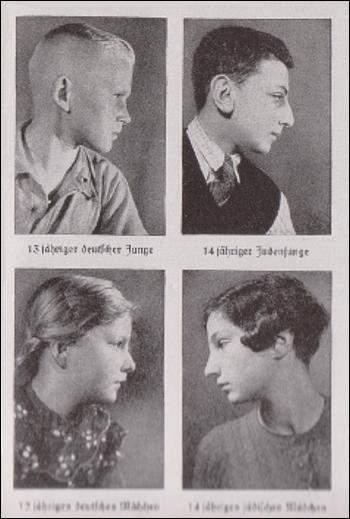
Fritz Fink criticised teachers who had not joined the propaganda campaign against the Jews. "A dislike of the Jews is innate in uncorrupted German youth. Today the child encounters the name Jew everywhere: in the newspapers, in conversations, in the songs of the S.A. and the Hitler Youth. The disgust with which they hear this name steadily increases, as does their dislike when they meet a representative of the Jewish race. However young he may be, a child asks himself the reasons for this dislike and disgust and wants an explanation from his teacher. That provides the foundation for successful education. But some teachers still lack the courage to address the Jewish question with enthusiasm. Nervously and shyly they avoid it.... These are the teachers who at the behest of the churches display pity and brotherly love to the deadly enemy, even when they sense and see that their own people is being destroyed by this deadly enemy. They are the weaklings, the cowards, those German teachers ruined by foreign powers. They avoid the Jewish question in education but rather than meeting the desire of the child for education and at the same time fulfilling one of their most important tasks." (28)
Tomi Ungerer was a student at a school in Colmar. In his autobiography, A Childhood under the Nazis (1998), he pointed out that The Jewish Question in Education, was used in his school. He remembers reading passages such as the "Jews have different noses, ears, lips, chins and different faces than Germans" and "they walk differently, have flat feet... their arms are longer and they speak differently." (29)
Jewish Children Expelled
It was not until 1938 that all Jewish children were finally banned from attending German schools. Armin Hertz now went to a Jewish school: "A decree had come out that Jewish teachers were not allowed to teach anymore in public schools. Therefore, there was no shortage of teachers in the Jewish schools. We went to a Jewish school and for us, of course, that was better." (30)
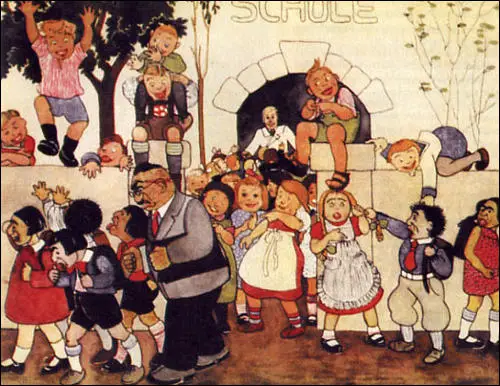
By 1938 two-thirds of all elementary school teachers were indoctrinated at special camps in a compulsory one-month training course of lectures. What they learned at camp they were expected to pass on to their students. (31) New mathematic textbooks were introduced and included "social arithmetic", which "involved calculations designed to achieve a subliminal indoctrination in key areas - for example, sums requiring the children to calculate how much it would cost the state to keep a mentally ill person alive in an asylum." (32)
Rebecca Weisner believed that going to Jewish schools caused serious problems: "These Jewish schools were all private... It was a regular school like the German one, but it wasn't German. Every day we had one hour of Hebrew. But everything else was like any other school... The other children were not allowed to play with me. They wouldn't talk to me. They called me names like dirty Jew... We had a German school across the street... So there was a lot of fighting between the two sides." (33)
Primary Sources
(1) Hildegard Koch, interviewed by Louis Hagen in 1946.
As time went on more and more girls joined the BDM, which gave us a great advantage at school. The mistresses were mostly pretty old and stuffy. They wanted us to do scripture and, of course, we refused. Our leaders had told us that no one could be forced to listen to a lot of immoral stories about Jews, and so we made a row and behaved so badly during scripture classes that the teacher was glad in the end to let us out. Of course, this meant another big row with Mother - she was pretty ill at that time and had to stay in bed and she was getting more and more pious and mad about the Bible and all that sort of thing. I had a terrible time with her.... But the real row with Mother came when the BDM girls refused to sit on the same bench as the Jewish girls at school...
The two Jewish girls in our form were racially typical. One was saucy and forward and always knew best about everything. She was ambitious and pushing and had a real Jewish cheek. The other was quiet, cowardly and smarmy and dishonest; she was the other type of Jew, the sly sort. We knew we were right to have nothing to do with either of them. In the end we got what we wanted. We began by chalking 'Jews out!' or 'Jews perish, Germany awake!' on the blackboard before class. Later we openly boycotted them. Of course, they blubbered in their cowardly Jewish way and tried to get sympathy for themselves, but we weren't having any. In the end three other girls and I went to the Headmaster and told him that our Leader would report the matter to the Party authorities unless he removed this stain from the school. The next day the two girls stayed away, which made me very proud of what we had done.
(2) Cate Haste, Nazi Women (2001) What We Knew: Terror, Mass Murder and Everyday Life in Nazi Germany (2005)
Education in "racial awareness" began at school and, from then on, women were constantly reminded of their racial duties to the "national community". A ceaseless tide of anti-Semitic propaganda flowed from the official organs of the Nazi Party. In schools the range of subjects studied by girls narrowed as domestic subjects and those preparing them for motherhood took precedence over academic study. Biology, alongwith political education, was compulsory. Here, the Nazi pseudoscience of race was taught. Girls learnt about "worthy" and "unworthy" races, about breeding and hereditary disease. They measured their heads with tape measures, checked the colour of their eyes and texture of their hair against charts of Aryan or Nordic "types", and constructed their own family trees to establish their biological, not historical, ancestry. School textbooks asked, "Do you know what kind of blood runs through your veins?" as part of education in awareness of the Aryan "blood community". They also expanded on the racial inferiority of the Jews.
(3) Armin Hertz, What We Knew: Terror, Mass Murder and Everyday Life in Nazi Germany (2005)
The anti-Semitism was very vivid in school... They were trying to teach us Nazi songs. I vividly remember this song they were marching in the street with. The Hitler Youth, young boys actually of our age, were singing, Das Judenblut vom Messer spitzt, geht's uns nochmal so gut. (The Jews' blood spurting from the knife makes us feel especially good). They were also singing it in the school.
(4) Richard Evans, The Third Reich in Power (2005)
The purpose of history was to teach people that life was always dominated by struggle, that race and blood were central to everything that happened in the past, present and future, and that leadership determined the fate of peoples. Central themes in the new teaching including courage in battle, sacrifice for a greater cause, boundless admiration for the Leader and hatred of Germany's enemies, the Jews....
Reading books... were filled with stories about children helping the Leader, about the healthy virtues of peasant life, or about the happiness of Aryan families with lots of children... By the mid-1930s there was scarcely a reading primer which did not mention one Nazi institution or other in a positive way. Picture-books for the very young portrayed Jews as devilish figures lurking in dark places, ready to pounce on the unsuspecting blond-haired German child.
(5) Bernhard Rust, National Socialist Germany and the Pursuit of Learning (1936)
There is, indeed, twofold evidence to show that something was wrong with education. In the first place, the high level of popular enlightenment had failed to protect the German people against the poisonous effects of Marxist teaching and other false doctrines. Large masses of people had fallen victims to them, whilst other sections - more especially those of higher education - had been unable to take up an effective stand against the spread of the poison. If they had, the events of 1918 and the succeeding period of national disintegration and deterioration would have been prevented.
In the second place, a careful study of the situation shows that the German people are sound to the core and are gifted with just as much national sentiment as any other. Hence, the temporary lowering of their previous high standards could not have been the result of any innate inferiority, but the reason must be sought in a faulty system of education, which - notwithstanding its high intellectual achievements - tended to impair the healthy spirit of the nation, men's energies and their soundness of judgment, and to produce selfishness and a deficient sense of national solidarity.
The attainment of high intellectual standards will certainly continue to be urged upon the young people; but they will be taught at the same time that their achievements must be of benefit to the national community to which they belong. As a consequence of the demand thus clearly formulated by the Nuremberg Laws, Jewish teachers and Jewish pupils have had to quit German schools, and schools of their own have been provided by and for them as far as possible. In this way, the natural race instincts of German boys and girls are preserved; and the young people are made aware of their duty to maintain their racial purity and to bequeath it to succeeding generations. As the mere teaching of these principles is not enough, it is constantly supplemented, in the National Socialist State, by opportunities for what may be called "community life". By this term we mean school journeys, school camps, school "homes" in rural neighbourhoods, and similar applications of the corporate principle to the life of schools and scholars.
History insists that every biological race deterioration coincides with the growth of big towns, that these latter exercise a paralysing effect upon community life, and that a nation's strength is rooted in its rural elements. Our National Socialist system of education pays due regard to these important considerations, and makes every effort, to take the young people from the towns to the country, whilst impressing upon them the inseparable connection between racial strength and a healthy open-air life.
(6) Helga Schmidt, What We Knew: Terror, Mass Murder and Everyday Life in Nazi Germany (2005)
In the area where we lived, here in Leptau, near the Freiburgerstrasse and St. Anthoniastrasse, there weren't any Jews. There were, however, Jews at school. I went to school with a Jewish girl. She was highly intelligent, pretty as a picture. She never let herself get mad. From the start, she kind of set the tone in class. One time during a physical fitness period when we had to let ourselves be timed with a stopwatch, she got angry with the teacher for some reason and said, "Let's all run really slow and make him mad." And we all did it too!
She had friends in school. She was good-natured. She was only protective about her private life. She never spoke about private matters. She never told us about her family life. There were other Jewish girls at school - not in my class, but in other classes-with whom she mostly hung around. They spoke Hebrew among themselves. When I left this school in 1935, she was still in that class. I don't know any details about what happened later to her...
Well, there had been a tendency over several years to present the Jews as exploiters. And when that has always been pounded into people's heads, people will also believe it. There was, however, a large part of the population who didn't think that was quite right and who said, "They're fleecing us. They're making money from us, and so on." Certainly there was something of a negative attitude toward the Jews, but before Hitler it did not exist to the same extent. One tolerated them. One let them live. There was never any particular sympathy for the Jews. But to directly label them as our enemies and exploiters, that came from Hitler.
At first, we shopped in Jewish stores, probably because they were less expensive than other stores. But then they closed little by little and eventually there weren't any more of them. They had been taken over by others. We went shopping in the Kaiserwerther Strasse. The larger shops there were all owned by Jews. That was well-known. Also it was well-known that department stores and larger shops in the city center were Jewish. Signs were taped on the windows and doors of the Jewish shops and department stores saying "Jew" and so on, and we didn't trust ourselves anymore to shop there because it was said that we were being watched. And we believed that.
Student Activities
Adolf Hitler's Early Life (Answer Commentary)
Heinrich Himmler and the SS (Answer Commentary)
Trade Unions in Nazi Germany (Answer Commentary)
Adolf Hitler v John Heartfield (Answer Commentary)
Hitler's Volkswagen (The People's Car) (Answer Commentary)
Women in Nazi Germany (Answer Commentary)
